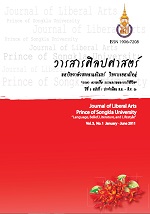ผ้าลีมา (ผ้าจวนตานี) ของจังหวัดชายแดนภาคใต้
Keywords:
.Abstract
The southern border provinces of Thailand in Ayudhaya period were important mercantile city states to foreign countries. Trade relations with other countries resulted in cross-cultural interaction between foreign newcomers and local people. An example of the cultural interaction was shown in the weaving of cloths of Muslim Thais in southern border provinces which resulted in local woven cloths hhaving some patterns, designs, techniques and colours similar to those of Indian cloth, Chinese cloth, Indonesian cloth, Khmer cloth, and Melayu cloth.
From the study of the data, it was found that cloths that had been used in daily lives and religious rites of Muslim Thais in Southern border provinces were of many various kinds: Karaduwor cloth, Karateekor cloth, Karapah cloth, Plae-nging cloth, Samarinda cloth, Sokae or Songket cloth, Acae cloth, Juan-tani cloth (kine limar) etc. These cloths were beautiful and unique. Besides, the designs and colours of these cloths told tales about the race, the status of those who wore it and ways of life of the people. This was like the mirror of the history of the Southern border provinces of Thailand.
Downloads
Published
How to Cite
Issue
Section
License
Copyright (c) 2017 วารสารศิลปศาสตร์ มหาวิทยาลัยสงขลานครินทร์ วิทยาเขตหาดใหญ่ (Journal of Liberal Arts Prince of Songkla University Hat Yai)

This work is licensed under a Creative Commons Attribution-NonCommercial-NoDerivatives 4.0 International License.
The authors retain the copyright to their article but the Journal of Liberal Arts, Prince of Songkla University reserves the exclusive rights to first publication.






